LisbonLisboaPortugal.com
The best independent guide to Lisbon
LisbonLisboaPortugal.com
The best independent guide to Lisbon
The E15 tram, Lisbon; the tram to Belem, a guide for 2025
The number 15 tram route connects the Praça da Figueira to the Jardim de Algés, and is the busiest tram route in Lisbon. This is an important public transport route as it is the main connection to the west of the city, including the Belém and Alcântara districts.
Neither Alcântara nor Belém are connected to the metro network; if you wish to travel to these districts using public transport, the E15 tram is the best option, and is notably better than the train or bus. This tram service is convenient, as it departs from the centre of the Baixa district (Praça da Figueira) and passes through the Praça do Comércio, one of the main plazas of Lisbon.
A single ticket on the E15 tram costs €3.10, but much cheaper fares are available using a 'Zapping ticket' (€1.61) or the 24-hour pass (€7.00); details of both are provided later in this guide. The tram takes 40 minutes to travel from Praça da Figueira to Belém, and the route is interesting, passing through many varied neighbourhoods.
The E15 route uses the modern "Articulado" and the newer "CAF" trams, not the quaint yellow trams that trundle along the E28, E12, and E24 routes.
As the primary public transport route to the western part of Lisbon, the number 15 tram can get very crowded. It is advisable to board it at the start of the route (at the Praça da Figueira) where there is a higher chance of getting a seat. Unfortunately, busy trams are plagued by highly skilled pickpockets, and care must be taken with valuables.
This article will provide an independent tourist guide to the Lisbon E15 tram, helping you get the most from this journey.
Related articles: The Belém district – Tram 28
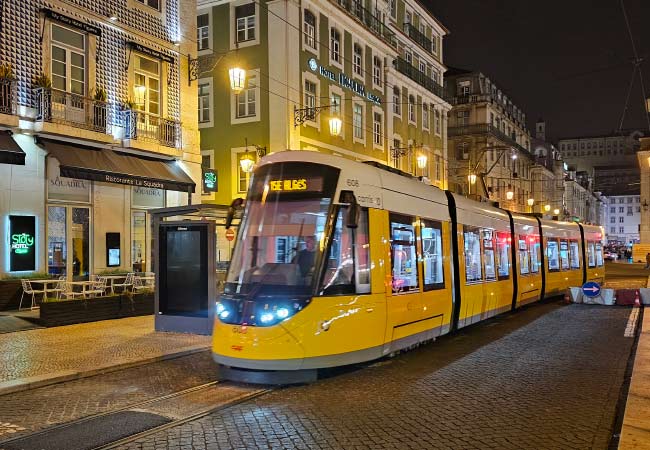
The E15 'CAF' tram passing through the Praça da Figueira
The E15 tram route
The E15 runs parallel to the Tejo Estuary and connects central Lisbon with western districts. The route passes through the Baixa, Cais do Sodré, Alcântara, Belém, and Algés districts.
The main stops along the E15 route that are of interest to tourists are:
• Praça da Figueira/Rua da Prata – For the centre of the Baixa district
• Praça do Comércio – For the south of the Baixa district
• Cais do Sodré – For Pink Street and TimeOut market
• Cais da Rocha – For the Museu Nacional de Arte Antiga
• Calvário – For LxFactory and Alcântara district
• Altinho (MAAT) – The MAAT Museum and eastern Belém
• Mosteiro dos Jerónimos – Main stop for Belém
• Largo da Princesa – For the Torre de Belém and western Belém
The interactive map below displays the route of the E15 tram, with the major stops shown in green. The map also includes the major tourist attractions along the route as yellow pins. (Note: Zoom out or in to see all the points):
Major tram stops: 1) Praça da Figueira/Rua da Prata 2) Praça do Comércio 3) Cais do Sodré 4) Cais da Rocha 5) Calvário 6) Altinho (MAAT) 7) Mosteiro dos Jerónimos 8) Largo da Princesa
Tourist attractions along the route: 9) Praça do Comércio 10) Pink Street 11) TimeOut Food market 12) Museu Nacional de Arte Antiga 13) LxFactory 14) Santo Amaro docks 15) Capela de Santo Amaro 16) MAAT museum 17) Museu dos Coches 18) Mosteiro dos Jerónimos 19) Padrão dos Descobrimentos 20) Torre de Belém
Most visitors travelling to Belém (7) will board at Praça da Figueira (1), Praça do Comércio (2), or Cais do Sodré (3). It is recommend boarding the tram at the Praça da Figueira (1), as this is the start of the route and there is a higher chance of securing a seat. Cais do Sodré (3) is a major train station, so expect lots of people to board here.
The E15 tram service is operated by Carris, the public transport company of Lisbon. All tram routes are preceded by the letter “E” which stands for Elétrico (tram).
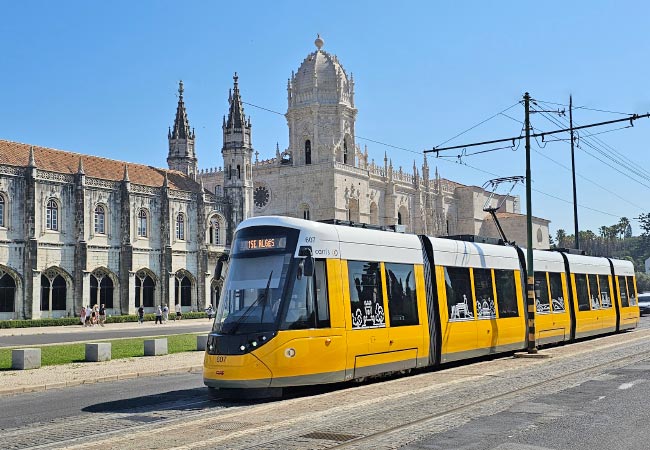
The E15 tram passing the Mosteiro dos Jerónimos in Belem
Fares for the E15 tram
A single fare for the E15 tram costs €3.10 and can be purchased from the driver or the onboard ticket machine.
The newer CAF trams accept contactless payment, but all other trams require cash – and often, the onboard ticket machines do not provide change. While sightseeing in Lisbon, it is always advisable to have some cash.
There are no return fares on the E15 tram, so purchasing tickets onboard for a return trip to Belem or Alcântara would cost €6.00. This is comparatively expensive and there are much cheaper options.
A more cost-effective alternative is the 'Zapping' ticket, which reduces the fare to €1.66. To use this option, credit is preloaded onto a 'Navegante' card – the reusable card used by all public transport in Lisbon. The only drawback is that credit can only be preloaded at a metro station and not on a tram.
Insight: Having a 'Navegante' card loaded with €15 is very useful while sightseeing in Lisbon, making it convenient and cheaper to hop on any bus or tram.
Another option is to purchase the 24-hour ticket that costs €7.00. This allows unlimited use of all public transport within Lisbon and also includes the Elevador de Santa Justa (€5.30), Elevador da Glória (€4.20) and the number 28 tram (€3.10).
Both the 24-hour ticket and the 'Zapping' ticket can be purchased from a ticket machine in any metro station. The nearest metro station to the Praça da Figueira tram stop is ‘Rossio’, located on the northern side of the plaza.
Related articles: Elevador de Santa Justa – E28 tram guide
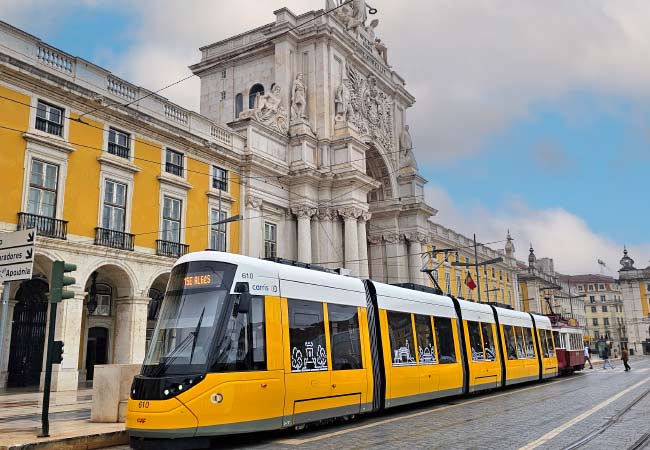
The ‘CAF’ E15 tram at the Praça do Comércio tram stop heading in the direction to Belem
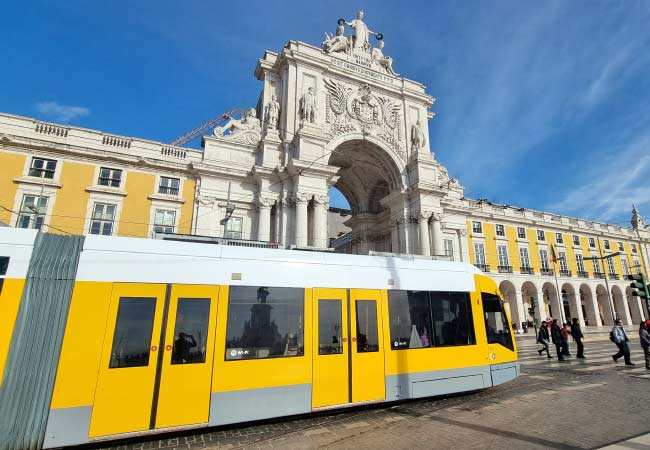
The slightly older Articulado tram at the same stop but heading to central Baixa
Why take the Tram to Belem and Alcântara?
There are many options to travel from central Lisbon to Belém, including tram, bus, train, taxi, and ride-hailing apps (Uber and Bolt).
The E15 tram is the best public transport option, and provides a direct service from Baixa, which is the centre for tourism in Lisbon. The tram has regular departures, with services as frequent as every 10 minutes.
It is also much easier to buy tram tickets than train ticket, as there can be very long queues to purchase train tickets in Cais do Sodré train station.
There are many bus services to Belem, but the variety of routes and different departure locations makes it confusing for visitors. The tram is much simpler by comparison. If you do want to take the bus, the best route is the number 728, which connects Restelo in the west to the Parque das Nações in the north and follows the Tejo estuary for most of the route.
If you are based in Cais do Sodré, the train is a viable option to travel to Belém, and the train journey is much quicker than the slow tram. The downside is that the train station can get extremely busy in the summer as everyone heads to the beaches to the west of Lisbon.
Insight: The quickest method of travel to Belém is to use a ride-hailing app, such as Uber and Bolt, with a typical fare of €6-8 for up to 4 people.
Related articles: How to travel to Belem?
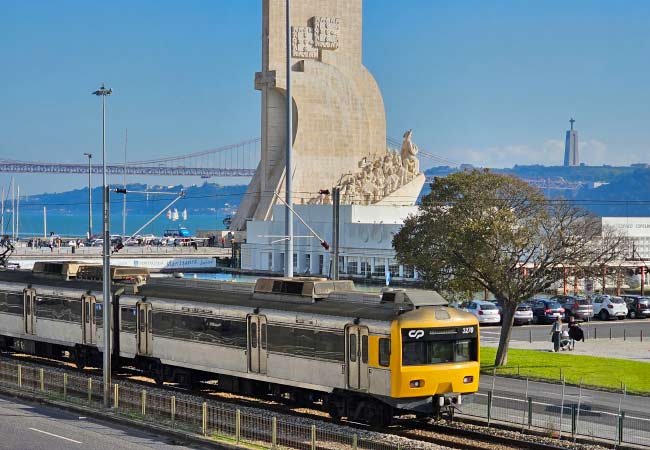
The train to Cascais passes through the Belem district
Pickpockets and the 15E tram
It is very sad that a section of this E15 tram article must be devoted to pickpockets, but they are very prevalent on the crowded trams, and you should be very wary of them.
These pickpockets are only ever opportunists and almost exclusively target tourists who fail to use common sense or are simply being careless. Always place valuables in bags, don't leave expensive cameras dangling from shoulders (cords can be cut) and wear backpacks or bags on your front.
One of the tricks they use is to snatch handbags or wallets as the tram doors are closing, so an easy method to avoid them, is not to stand close to the door. The pickpockets are equally likely to be men or women, often work as a group, and their clothes blend into the crowd.
Related articles: Is Lisbon safe?
The E15 timetables
The E15 is an important public transport link and the frequency reflects this. The tram services start early in the day (6am) and continue late into the night (1am), with five hourly departures between 7am-10pm (reducing to four on Sundays and public holidays).
At all of the major tram stops, there information boards which accurately display the time of the next departure. These are much more useful than the printed timetables, which can be seen on the Carris website:
www.carris.pt/
(link opens a new tab, as it is a pdf it may download on mobile phones)
Alternatives to the E15 tram
The E15 tram can get very crowded and, as a modern tram, is not the same enjoyable experience as the classic trams that rattle and screech through Alfama. Another suitable alternative to the E15 tram is the number 728 bus service (unhelpfully labelled as Portela to Restelo).
This very useful bus service follows the entire Tejo estuary from Belem (in the west) to the Parque das Nações (in the north east) and passes the Baixa and Alfama districts. There are at least three departures every hour and a ticket costs €2.00 (or is included in the 24-hour public transport ticket).
In Belem, the 728 bus departs from the same stop as the tram while in Baixa it departs from just to the west of Praça do Comércio . The entire bus route can be seen here:
www.carris.pt
(link opens new tab)
Interesting sights along the E15 tram route
The Lisbon tram 15 is the main public transport route to the west of Lisbon and for much of the journey it follows the Tejo Estuary. Interesting tourist attractions along the route include:
Cais do Sodré – A trendy district, which has shrugged off its seedy reputation to become the nightlife hub of Lisbon. The nightlife and bar culture is centred around Pink Street while close by is the TimeOut food market a great place to try different Portuguese dishes.
Av. Infante Santo – A fashionable section of Lisbon that has transformed old docks into stylish restaurants, bars and clubs, which overlook the Doca do Espanhol marina and the Ponte 25 de Abril suspension bridge.
Calvário - This tram stop is close to the LxFactory, an abandoned factory that has been converted into an artisan and contemporary centre. Found in the former warehouses are trendy restaurants, independent artists stalls and uber-cool bars. To understand why Lisbon has become such a popular destination for tech start-ups and digital nomads this is the place to head to.
Santo Amaro – Location of the Carris tram and public transport museum: museu.carris.pt/
The Museu Nacional de Arte Antiga is the national art gallery of Portugal and exhibits the country's most important collection of early European, Asian, and African art. The collection was established in 1884 to preserve important religious artworks following the dissolution of religious orders in Portugal in 1834.
The museum's vast collection includes a rich array of paintings, sculptures, and textiles, ranging from the Middle Ages to the early 19th century. Among its most renowned pieces is the "Panels of Saint Vincent" by Nuno Gonçalves, a masterpiece of Portuguese Renaissance art.
The museum's setting is equally impressive, housed in the Palácio Alvor-Pombal, a former royal palace. This is one of the finest museums in Lisbon, and the extensive collection can easily fill half a day.
Tram stop: Cais da Rocha
Official website: museudearteantiga.pt
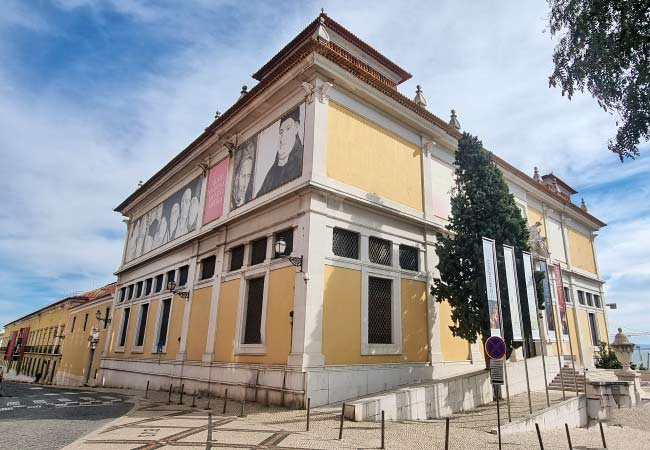
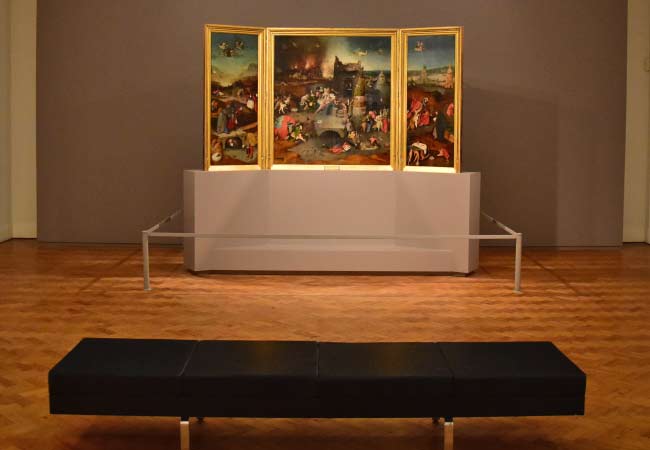
The "Temptations of Saint Antony" is such an involved painting it needs time to sit and admire
The Time Out Market is a vibrant food market located in the bustling Mercado da Ribeira at Cais do Sodré. Opened in 2014, it transformed a wing of the traditional Mercado da Ribeira into a modern food hall, where some of Portugal's most talented chefs and restaurateurs showcase their culinary creations.
Featuring over 40 spaces, including kiosks, bars, and shops, the market presents a diverse range of options, from traditional Portuguese dishes to contemporary global cuisine. Today, it has become very tourist-focused, with prices being comparatively expensive, and it can be a scramble to find a seat at peak times. However, it is a very social setting, enjoyable for lunch or dinner, and it’s also a great place to meet fellow visitors.
Tram stop: Cais do Sodré
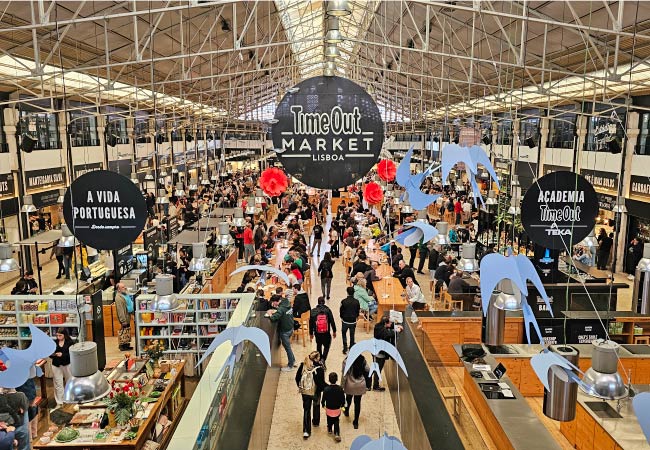
Discover more of Lisbon with our most popular guides
If you've found our content valuable, we'd welcome your support.
The digital publishing landscape has evolved significantly. As a small independent publisher, we face growing challenges. Search engines increasingly favour paid content over organic results, while AI-generated content often reproduces original work without attribution.
To support our work, please consider bookmarking this page (press Ctrl + D) for quick access. If you find an article helpful, we'd be grateful if you'd share it with friends on social media.
For specific questions, please see our Reddit community at r/LisbonPortugalTravel.
Should you notice any outdated or incorrect information, please contact us at [email protected]
Thank you for helping us continue to provide valuable content in an increasingly challenging digital environment.
A complete list of all of our Lisbon articles
If you've found our content valuable, we'd welcome your support.
The digital publishing landscape has evolved significantly. As a small independent publisher, we face growing challenges. Search engines increasingly favour paid content over organic results, while AI-generated content often reproduces original work without attribution.
To support our work, please consider bookmarking this page (press Ctrl + D) for quick access. If you find an article helpful, we'd be grateful if you'd share it with friends on social media.
For specific questions, please see our Reddit community at r/LisbonPortugalTravel.
Should you notice any outdated or incorrect information, please contact us at [email protected]
Thank you for helping us continue to provide valuable content in an increasingly challenging digital environment.




































